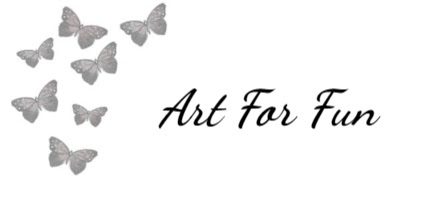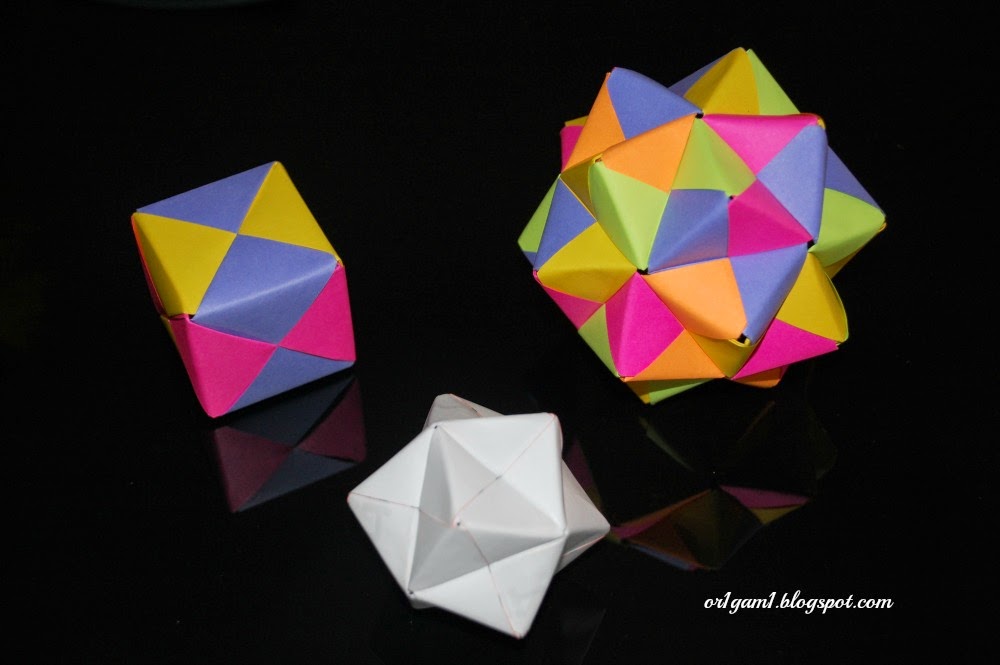03 November 2014
21 October 2014
Star Flower
Star Flower by Meenakshi Mukherji
Reference : Exquisite Modular Origami by Meenakshi Mukherji
No of units : 30
Paper size : 3 inch x 6 inch rectangles
Paper type : Origami paper
09 October 2014
Vortex Dodecahedron
Vortex Dodecahedron
Reference : Exquisite Modular Origami by Meenakshi Mukherji
No of units : 30
Paper size : 3 inch squares
Paper type : Origami paper
01 October 2014
Pinwheel Dodecahedron Variation
Reference : Exquisite Modular Origami by Meenakshi Mukherji
No of units : 30
Paper size : 3 inch squares
Paper type : Origami paper
24 September 2014
Striped Sonobe Icosahedron
Dear readers,
Today is Mahalaya, beginning from tomorrow is Navaratri - celebration of good triumph. Wishing everybody a very happy Navaratri.
Thanks and Regards,
Deepika
Reference : Marvelous Modular Origami by Meenakshi Mukherji
Paper used : Origami paper
No of units : 30
Paper Size : 6 inch square
Top: Left to Right : Striped Sonobe Icosahedron, Pinwheel Dodecahedron, Daisy Sonobe, Patterned Icosahedron. Bottom: Left to Right : Normal Sonobe , Dodecahedron, Sonobe cube, Icosahedron
13 September 2014
Pinwheel Dodecahedron
Reference : Exquisite Modular Origami by Meenakshi Mukherji
No of units : 30
Paper Size : 6 inch square
Paper type : Origami Paper
23 August 2014
Patterned Icosahedon
Above Photo : Patterned Icosahedron vertex (left) and triangular face (right)
Above Photo : Triangular face of Patterned Icosahedron and simple Icosahedron
Above Photo : Vertex of Patterned Icosahedron and simple Icosahedron
Designer : Meenakshi Mukerji
Reference: Ornamental Origami
Video Tutorial :
No of units : 30 rectangles
Paper used : origami paper
Paper size : 3 inch : 6 inch
16 August 2014
Daisy Sonobe Cube
Reference : Marvelous Modular Origami by Meenakshi Mukherji
No of Units : 6
Paper type : Origami Paper
Paper size : 6 inch square sheets
10 August 2014
What is Sonobe?
Above Photo : Sonobe Cube, Sonobe Octahedron and Sonobe Icosahedron
I am writing this article referring to wiki definition of Sonobe (http://en.wikipedia.org/wiki/Sonobe), borrowing facts and the below table from wiki to note down some points for my quick reference.
The creator of Sonobe is Mitsunobu Sonobe. A single sonobe unit looks like a parallelogram with 135 and 45 degrees angle. Three of such Sonobe units forms a triangular pyramid (open bottomed). In geometry placing such triangular pyramids on each of the four triangular faces of a tetrahedron we get a cube. Similarly by placing triangular pyramids on octahedron and icosahedron results in augmented octahedron (Sonobe Octahedron) and augmented icosahedron (Sonobe Icosahedron).
Since the triangular pyramid we obtain by joining 3 Sonobe unit is open bottomed, the underlying polyhedra (tetrahedron/octahedron/icosahedron) is imaginary. Sonobe units is only for the pyramids.
Since the triangular pyramid we obtain by joining 3 Sonobe unit is open bottomed, the underlying polyhedra (tetrahedron/octahedron/icosahedron) is imaginary. Sonobe units is only for the pyramids.
The word Augmented in geometry means that a pyramid has been joined to a face of the solid in question. Here the solid in question is octahedron and icosahedron (or tetrahedron). We are joining triangular pyramid on it's faces. Hence we say augmented Octahedron and augmented icosahedon.
| Number of Sonobe Units | Faces | Edges | Vertices |
|---|---|---|---|
| s | 2s | 3s | s + 2 |
| 6 | 12 | 18 | 8 |
| 12 | 24 | 36 | 14 |
| 30 | 60 | 90 | 32 |
To explain the above table consider example of Sonobe Cube, we need 6 Sonobe units to make a Cube.
Faces (applying formula) 2 * 6 = 12
(Note : It's a triangular face - not to be confused with face of cube. As a matter of fact One face of Cube has 2 faces of Sonobe Cube)
(Note : It's a triangular face - not to be confused with face of cube. As a matter of fact One face of Cube has 2 faces of Sonobe Cube)
Logic : A pyramid that we place on the face of tetrahedron has 3 triangular faces. We need 4 pyramids to make a cube. Hence 3 * 4 = 12
Edges (applying formula) 3 * 6 = 18
Logic : Edges of tetrahedron + 3 * (number of pyramids) = 6 + (3 * 4) = 18
Vertices (applying formula) 6 + 2 = 8
Logic : Vertices of tetrahedron + apex of pyramids (equal to number of faces of tetrahedron) = 4 + 4 = 8
Same logic can be applied for Augmented octahedron and Augmented icosahedron. It might be little confusing to visualize the above logic with the Sonobe cube since the pyramids are not protruding. The below video might help visualizing.
Basically a cube can be divided into five tetrahedra - if a cube is triangulated such that the central tetrahedron is regular. A tetrahedron is a triangular pyramid.
Reference: http://www.ics.uci.edu/~eppstein/projects/tetra/
Above Photo : Sonobe Octahedron
Sonobe Octahedron (Augmented Octahedron) might help in better understanding.
Tetrahedron, Octahedron and Icosahedron are Platonic Solids. Cube and Dodecahedron are the other Platonic Solids. A cube has square faces, Dodecahedron has pentagonal faces - hence triangular pyramids cannot be placed.
Augmented Icosahedron / Sonobe Icosahedron is widely folded in Origami to obtain attractive floral balls. A Sonobe Icosahedron has 20 pyramids because Icosahedron has 20 (triangular) faces. Similarly a Sonobe Octahedron has 8 pyramids because Octahedron has 8 (triangular) faces and Sonobe Cube has 4 pyramids because tetrahedron has 4 (triangular) faces.
Note: I have used Sonobe Icosahedron and Augmented Icosahedron names interchangeably (Similarly Sonobe Octahedron and Augmented Octahedron).
04 August 2014
With Meenakshi Mukerji
Above Photo : Origami models display by Meenakshi Mukerji in Sunnyvale Public library
(All models on display are designed and folded by herself)
I was very happy to meet origami artist and author Meenakshi Mukerji on Friday (1 Aug 2014). She has been designing and displaying several modular origami models for over two decades. Her models are for public display in Sunnyvale public library. Last year her Origami exhibit in Sunnyvale Public Library (in the same curio cabinet) inspired me to try Origami in it's modular form. I folded some of her designs Sun Burst, Star Burst, Ixora, Impatient Trillium Bouquet, Tuberose and went on to try Intersecting planes from her book Ornamental Origami. Lately I have folded some more of her designs. I was glad to meet her just as I started to post them in this blog. I will continue to post the remaining models I folded from her book.
26 July 2014
Whipped Cream Star
Above Photo : Whipped Cream Star designed by Meenakshi Mukerji
Above Photo : Another view of Whipped Cream Star Kusudama
Above Photo : Reflection of the model in my dining table
Above Photo : Close up view of the model
Reference : Origami Inspirations by Meenakshi Mukerji
Paper type : Origami paper
No of units : 30
Paper size : Rectangles of size 3 inch x 6 inch
Note : In step 6, I missed a folding. Instead of mountain folding the point A to the tip and valley folding the sides, I valley folded the sides without mountain folding point A to tip. This way, I got stuck at step 12.
Loved this kusudama, folding was fun.
Loved this kusudama, folding was fun.
19 July 2014
Flower Dodecahedron
 |
Above photo : Flower Dodecahedron |
Paper type : Printer paper
No of units : 12 for the flowers (yellow) and 30 pink units to connect the flowers
Paper size : 8.5 inch square sheets for flowers and to make pink units
Started on June 1st 2014 and completed on 5th June 2014
12 July 2014
Daffodils
Above pic : Daffodils Floral Ball designed by Meenakshi Mukerji
Above pic : Another view of floral ball for the center pyramids view
Above pic : close up view of a flower
 |
Above Photo : Dimpled model with curls and Daffodils Floral Balls |
I added a tab in the header menu. It's a direct link to my Flickr photo gallery dedicated to Origami. It's nice and colorful to see all the photos together.
Reference : Exquisite Modular Origami by Meenakshi Mukerji
No of units : 30 square sheets
Paper used : color printer paper
Paper size : 4 inch square sheets
03 July 2014
Dimpled Model with Curls
Above Photo : Dimpled Model with Curls designed by Meenakshi Mukerji
Above Photo : The dimpled curly model reflection in my glassy black dining table
An interesting observation in the above photo is it causes optical illusion. The central dimple in the front appears to be a pyramid. It looks like there is a pentagonal pyramid inside a pentagonal bowl where in reality it is actually an elevated pentagonal bowl. This is a good example of optical illusion!
An interesting observation in the above photo is it causes optical illusion. The central dimple in the front appears to be a pyramid. It looks like there is a pentagonal pyramid inside a pentagonal bowl where in reality it is actually an elevated pentagonal bowl. This is a good example of optical illusion!
Above Photo : Close up view of the dimple
Above photo : The model and it's reflection
Reference : Exquisite Modular Origami by Meenakshi Mukerji
No of units : 30 square sheets
Paper used : color printer paper
Paper size : 4 inch square sheets
21 June 2014
28 June 2014
Tomoko Fuse Boxes - The entire collection
Origami Boxes - Tomoko Fuse - Entire Collection
- Lid of tsuzura and Base of tsuzura
- Square Boxes : First and Second Series and Lozenge Lid Variation
- Lid of a square box : fancy pinwheel
- Octagon Box : Lid of an octagon Box (little flower and double stars) : Base of an octagon box
- Triangle Box : Small, Medium and Large sizes
- Hexagon Box : Lid of a hexagon box (six petal pinwheel and flower and star) and base of hexagon box
Folded in the month of March 2014
21 June 2014
Hexagon Box - Tomoko Fuse
Above Photo : Hexagon boxes with lids - Right: six-petal pinwheel, left : flower and star
Above photo : Hexagon box bases and front view of the two lids
Above photo : Back view of hexagon box base and two lids
Reference: Origami Boxes by Tomoko Fuse
Paper : Origami paper
Paper size: 6 inch square papers
No of units : 6 for each lid/base
14 June 2014
Triangle boxes - Tomoko Fuse
 |
| Above Photo : Triangle box |
Above Photo : Left to right, triangle box large, medium and small size
Above Photo : Triangle boxes stacked
Reference: Origami Boxes by Tomoko Fuse
Paper : Color Printer Paper
Paper size: 4 inch square papers
No of units : 3 for each lid/base
09 June 2014
Octagon box - Tomoko Fuse
Above photo: Right - lid of an octagon box: little flower, Left - lid of an octagon box: double stars
Above photo: Base of an octagon box
Above photo: Back view of the bases and lids
Reference: Origami Boxes by Tomoko Fuse
Paper : Origami paper
Paper size: 6 inch square papers
No of units : 4 for each lid/base
06 June 2014
Lid of a square box : Fancy pinwheel - Tomoko Fuse
Above Photos: Fancy pinwheel Lid of a square box
Reference: Origami Boxes by Tomoko Fuse
Paper : Origami paper
Paper size: 6 inch square papers
No of units : 4 for each lid/base
01 June 2014
Square Boxes - Tomoko Fuse
Above photo : Front view of different designs of square boxes base and lids
Above Photo : Back view of different designs of square boxes base and lids
Reference: Origami Boxes by Tomoko Fuse
Paper : Color Printer paper
Paper size: 4 inch square papers
No of units : 4 for each lid/base
Subscribe to:
Posts (Atom)















































